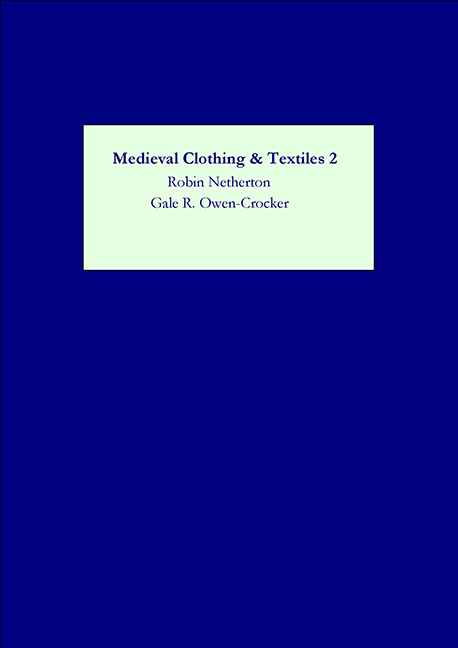Book contents
- Frontmatter
- Contents
- Illustrations page
- Tables
- Contributors
- Preface
- 1 Dress and Accessories in the Early Irish Tale 'The Wooing Of Becfhola”
- 2 The Embroidered Word: Text in the Bayeux Tapestry
- 3 “De Fil d'Or et de Soie”: Making Textiles in Twelfth-Century French Romance
- 4 Biffes, Tiretaines, and Aumonières: The Role of Paris in the International Textile Markets of the Thirteenth and Fourteenth Centuries
- 5 'Clothing Themselves in Acres”: Apparel and Impoverishment in Medieval and Early Modern England
- 6 'Ye Shall Have It Cleane”: Textile Cleaning Techniques in Renaissance Europe
- 7 Fleas, Fur, and Fashion: Zibellini as Luxury Accessories of the Renaissance
- 8 The Matron Goes to the Masque: The Dual Identity of the English Embroidered Jacket
- Recent Books of Interest
- Index
7 - Fleas, Fur, and Fashion: Zibellini as Luxury Accessories of the Renaissance
Published online by Cambridge University Press: 14 February 2019
- Frontmatter
- Contents
- Illustrations page
- Tables
- Contributors
- Preface
- 1 Dress and Accessories in the Early Irish Tale 'The Wooing Of Becfhola”
- 2 The Embroidered Word: Text in the Bayeux Tapestry
- 3 “De Fil d'Or et de Soie”: Making Textiles in Twelfth-Century French Romance
- 4 Biffes, Tiretaines, and Aumonières: The Role of Paris in the International Textile Markets of the Thirteenth and Fourteenth Centuries
- 5 'Clothing Themselves in Acres”: Apparel and Impoverishment in Medieval and Early Modern England
- 6 'Ye Shall Have It Cleane”: Textile Cleaning Techniques in Renaissance Europe
- 7 Fleas, Fur, and Fashion: Zibellini as Luxury Accessories of the Renaissance
- 8 The Matron Goes to the Masque: The Dual Identity of the English Embroidered Jacket
- Recent Books of Interest
- Index
Summary
Perhaps one of the most curious fashions of all time is the luxury fur piece of the late fifteenth and sixteenth century. In its simplest form, this was the pelt of a marten or sable worn draped over the wearer's shoulders or arm, or carried in the hand. At its most extravagant, the animal's skin featured a jeweled head, and often paws, of gold or crystal, and the whole was generally attached by a ring on the muzzle to a chain and worn on a girdle.
The first known mention of this luxurious item occurs in 1467 in the inventory of Charles the Bold, Duke of Burgundy: “a marten for putting around the neck, the head and feet of gold with ruby eyes, with diamonds on the muzzle and paws;” but no pictorial evidence exists as early as this citation, and no other written or visual examples appear until a Milanese document, dated February 1489, records an ungarnished sable worn by Isabella d'Aragon, Duchess
A version of this paper was presented in May 2004 at the International Congress on Medieval Studies at Kalamazoo, Michigan. My work on this subject is dedicated to the memory of Professor Diane Martel, who showed me the way.
of Milan. (A summary of documentary references to these items follows this article.)
In terms of the fashion's development, both the visual and the written record suggest a northern Italian origin for zibellini—that is, sables—as the Italians referred to them. The vogue began with simple, ungarnished pelts, as noted in a document of 1490 in which Isabella d'Este writes to Giorgio Brognolo, her agent in Venice,“Wishing for a beautiful sable lining for a sbernia, we would like you to buy eighty pelts of the most excellent quality, even if you should look everywhere in Venice, and see if you can find us one to be held by hand, with the bone in the head, as we wrote to you earlier, even if it should cost 10 ducati, as long as it is beautiful, we don't mind the cost.”
- Type
- Chapter
- Information
- Medieval Clothing and Textiles 2 , pp. 121 - 150Publisher: Boydell & BrewerPrint publication year: 2006

